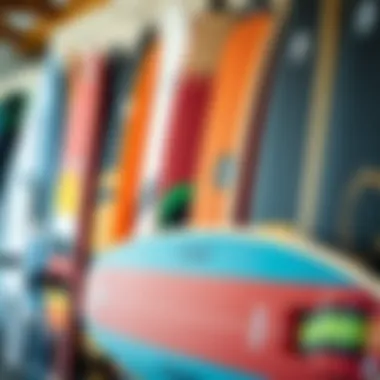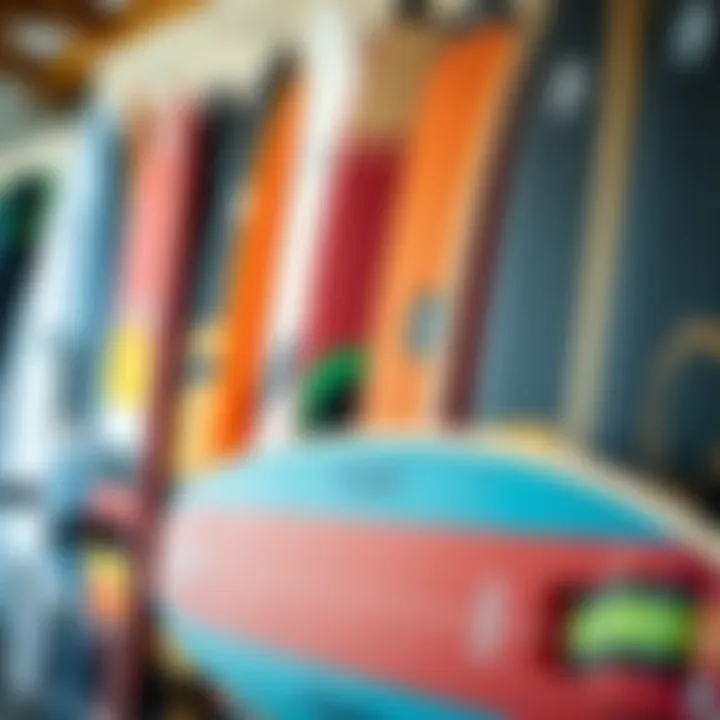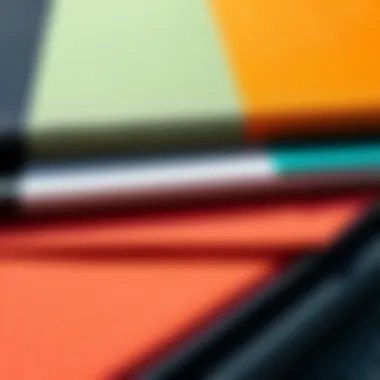A Complete Guide to Selecting Your Kite Board


Intro
When diving into the thrilling world of kiteboarding, one of the first decisions that kiteboarders face is selecting the right gear. The options are plentiful, and without an understanding of what to look for, it can be overwhelming. Buying a kite board isn't just about grabbing the flashiest option at the shop; it requires careful consideration of various factors. Whether you're a beginner eager to catch your first waves or a seasoned rider looking to elevate your performance, understanding the essentials makes all the difference.
In this guide, we will dissect the fundamental elements involved in purchasing a kite board. The focus will encompass the types of kite boards available, the materials used in their construction, and performance specifics that cater to different skill levels. Also, we will look into important maintenance practices that keep your equipment in top shape, which in turn enhances your overall kiteboarding experience. Not only will we discuss budget considerations, but we will also shine a light on recent trends so you can be well-informed about what’s hot in the market.
This overview aims to equip you with the knowledge you need to navigate the choices ahead with confidence. Let’s embark on this adventure together!
Gear Selection
Choosing the right gear is akin to finding a proper dance partner; there needs to be harmony and compatibility. The following sections will take a closer look at the core components of kiteboarding gear, with a key focus on kite boards and their critical role in mastering the winds.
Types of Kite Boards
When browsing for kite boards, you'll encounter a range of types, each catering to different styles and conditions. These can broadly be identified as:
- Twin Tip Boards: Best known for their versatility, these boards allow riders to ride in both directions, making them ideal for beginners and those who enjoy freestyle tricks.
- Directional Boards: These are designed for wave riding and are not symmetrical, meaning they are best suited for riding in one direction.
- Foil Boards: A newer addition to the market, these boards utilize a hydrofoil to lift above the water, providing a unique riding experience that can be enjoyed in light winds.
Understanding these distinctions helps you determine which type aligns with your riding style and skills.
Choosing the Right Board
Selecting a board requires a thoughtful approach. Here are some aspects to consider:
- Skill Level: Your experience plays a crucial role. Beginners should opt for wider, more stable boards, while advanced riders might prefer a smaller, more maneuverable board for tricks.
- Riding Style: If you fancy freestyle or big air, you might lean toward twin tips. Conversely, if wave riding is your jam, directional boards are your best bet.
- Weight and Size: A general guideline is that riders should choose boards that match their body weight and skill. Heavier riders often need a longer board for optimal performance.
- Material and Construction Methods: Boards can be made from materials like fiberglass, carbon fiber, or wood. Each offers distinct performance benefits, including weight, durability, and stiffness.
An informed choice leads to a more enjoyable ride, ensuring you make the most of your kiteboarding sessions. Remember that the board isn't just a tool; it's an extension of your own capabilities.
"A kite board, much like a musician’s instrument, must resonate with its player to create something beautiful."
As you take this journey, keep in mind that it's not about just getting any board; it's about finding one that complements your skills and amplifies your passion for kiteboarding.
Understanding Kite Boards
Kiteboarding presents an exhilarating blend of sports and nature, blending excitement with the beauty of wind and water. This article aims to shed light on the essence of kite boards, illuminating the myriad choices available to aspiring kiteboarders. Understanding kite boards is paramount, as the right selection can make or break your experience on the water. It's not just about hopping on a board; it’s about grasping how different boards function and suit your needs.
Definition and Purpose
A kite board can be seen as the bridge between the kite and the rider, facilitating movement and performance on the water. Essentially, these boards are designed to be lightweight yet durable, allowing riders to harness the wind effectively. The purpose goes beyond just gliding across the water; it involves performance, stability, and maneuverability, catering to both recreational enthusiasts and serious competitors.
Types of Kite Boards
When you set out to find the right kite board, you'll quickly discover that they come in various shapes and styles. Each type possesses distinct characteristics that cater to different riding styles and skill levels.
- Freeride Kite Boards
These boards stand out for their versatility. Freeride kite boards are designed for a broader audience and can be used in a variety of wind and water conditions. Most notable is their balanced shape, making them stable and easy to control. This characteristic makes them an excellent choice for beginners who are just dipping their toes into the kiteboarding world. They also allow for some tricks and jumps, providing a stepping stone to more advanced styles. - Freestyle Kite Boards
These boards are designed with the bold rider in mind. The primary focus here is on agility and responsiveness, which empowers the rider to perform tricks. The unique feature that sets freestyle boards apart is their flat rocker line. This design allows for a more stable platform for jumps, spins, and other maneuvers. For those who are looking to master aerial moves, a freestyle kiteboard would naturally be a preferred choice, although they can be challenging to control in choppy water. - Wave Kite Boards
Tailored for those who relish riding in ocean waves, wave kite boards exhibit a more surfboard-like design. Their narrower width helps them cut through chop and provides better maneuverability on waves. These boards often feature a pronounced rocker, allowing riders to execute sharp turns and ride the waves effectively. For the adventurer who thrives on ocean waves, this type of board is indispensable, although it might not perform as well in flat conditions. - Race Kite Boards
If speed is your jam, then race kite boards are built for you. These boards are longer and have a sleek design aimed at reducing drag and maximizing speed on flat water. The downside, especially for newcomers, is that they require more skill and wind power to manage effectively. However, for seasoned riders who are in pursuit of speed and performance in racing contexts, race kite boards offer a thrilling experience.
Materials and Construction
When it comes to kite boards, the materials and construction play a significant role in determining the performance and durability. Different boards utilize various materials to optimize their function.
- Wood
Traditionally, wood has been a common choice for kite boards due to its natural resilience and flexibility. One of the key attractions of wood is that it absorbs vibrations well, providing a smoother ride. However, wood can also be heavier than other materials, which can affect performance in terms of speed and agility. It’s thus often chosen by riders looking for stability instead of speed. - Plastic
Plastic boards are known for their affordable pricing and durability. While they may not have the same performance level as wood or fiber reinforced alternatives, they provide a sturdy option that is less likely to suffer damage in rough conditions. This makes plastic an attractive choice for beginners who are still learning the ropes and do not want to invest heavily right away. - Fiber Reinforced Materials
This category leads the pack when it comes to high-performance kiteboards. Fiber reinforced boards are crafted using advanced composites like carbon or fiberglass, which results in a lightweight yet incredibly strong product. These materials help maintain shape while providing exceptional responsiveness and agility on the water. Their potential downside is often reflected in the price, as they can be quite an investment, so choosing wisely based on the skill level and riding style is key.
In essence, selecting the right kite board involves much more than simply picking a shiny new piece of gear. It's about aligning your preferences, skill level, and the conditions you plan to ride in with the nuances of each type of board and its construction. Knowledge is your best ally as you navigate the waves.
Selecting the Right Kite Board
When it comes to kiteboarding, choosing the right kite board is like picking the right tools for a craftsman. This decision shapes not only how you perform on the water but also your overall enjoyment. The kite board you select can influence your ability to master new tricks, compete in races, or simply enjoy a sunny day on the beach.


In this section, we’ll delve into important elements that influence your choice. Understanding your skill level, performance specs, and personal riding preferences will help guide your decision. A well-chosen board can mean the difference between soaring through the air and feeling out of your depth.
Assessing Skill Level
Understanding your skill level is the cornerstone of selecting the right kite board. Whether you're just getting your feet wet or you've already got a few years under your belt, knowing where you stand helps in identifying what board will meet your needs.
Beginners typically benefit from boards that offer a forgiving ride, which makes it easier to learn and progress without frequent spills. Look for wider boards that provide stability and better upwind performance. For those who are more seasoned, the focus may shift toward boards that promote agility and performance, as your technique will allow you to handle more specialized shapes and sizes.
Performance Specifications
In this part, we’ll get into the nitty-gritty of kite board features. There are several critical dimensions and characteristics that can dramatically affect your ride.
Length
Length is crucial because it directly influences how the board performs in different conditions. A longer board generally offers better stability and speed, making it a popular choice for those who enjoy freeriding and racing. This type of board excels in choppy waters and lets you maintain speed without creating much drag.
On the flip side, shorter boards are often preferred by freestyle riders who want quick turns and a more playful feel. Just be cautious, as shorter lengths can sometimes sacrifice stability in rough conditions. Ultimately, finding a balance that aligns with your style and preferred riding conditions is key.
Width
Width, another indispensable factor, impacts early planing and the ability to ride in lighter winds. Wider boards tend to be more stable and provide a greater surface area for floating on the water, which is especially useful for beginners or those who want a comfortable ride.
However, a wider board might not give the same quick response that a narrower board offers, which is often favored by more advanced kiteboarders looking to perform tricks. Pay attention to what you value more—stability or dexterity—when making your choice.
Rocker Line
The rocker line—the curvature of the board from tip to tail—also plays a significant role in performance. A board with a higher rocker line can cut through choppy water and turn with ease, which can boost confidence during tricky moves. This type of board can also help you land better by absorbing impact.
Conversely, a flatter rocker line allows for faster speeds and helps in maintaining a solid grip, which is advantageous when riding in smooth waters. Think about where you'll predominantly be riding. Different conditions demand different rocker styles.
Rails
Lastly, the rails of the board influence how it interacts with the water. Sharper, more pronounced rails will give you a carvy feel and enhance grip, which is ideal for aggressive turns and during jumping. Softer rails, on the other hand, allow for easier transitions and smoother rides.
A good understanding of the different rail designs can really enhance your performance. Choose the design that aligns with your riding habits; it’s about what feels right for you when you’re on the water.
Personal Riding Style
Personal riding style is a nuanced aspect of kiteboarding, often evolving as one gains experience. Your preferences regarding terrain, tricks, or speed can dictate your board choice. Freeriders may seek versatile boards that perform well in diverse conditions, while racers will prioritize speed and precision. Freestyle enthusiasts often want boards that let them push their limits with innovative tricks and aerial maneuvers.
It’s essential to reflect on your riding habits and aspirations. Consider what you enjoy most when kiteboarding, and let that inform your choice. Each type of board has its flair and can suit different styles of riding, aligning perfectly with how you want to express your passion on the water.
Budget Considerations
When it comes to the realm of kiteboarding, the price of the gear can range from wallet-friendly to downright splurge-worthy. It’s essential to understand the financial aspect of this sport, as it can greatly influence your choices. Budget considerations not only encompass the initial purchase of a kite board, but also the long-term investment in maintenance, gear compatibility, and replacement parts. Evaluating your options in terms of expenses can help you find a kite board that matches your skill level and riding aspirations without breaking the bank.
Understanding Price Brackets
Kite boards typically fall into varied price brackets. Many new kiteboarders are often shocked to see the range of prices available. At the low-end, you may find entry-level boards costing around three hundred dollars. These boards are often built with basic materials and designed for ease of use, perfect for learning . On the opposite end, high-performance boards can soar well above a thousand dollars. These premium kits cater to experienced riders who demand superior materials and advanced features.
- Entry-Level Boards: Affordable options for beginners – typically priced 300-500 dollars.
- Mid-Range Boards: More durable and feature-rich priced between 500-800 dollars.
- High-End Boards: Top-notch construction and technology, costing from 800 dollars upwards.
Understanding where your budget sits helps you narrow down your options, making the search a whole lot easier, especially when there are so many choices out there.
Balancing Cost and Quality
It’s a delicate dance to balance cost and quality when selecting a kite board. Going for the cheapest option might save a bundle right now, but it can also lead to frustration later on. Poor quality boards might lack durability and perform inadequately, which could hinder your development as a rider. This is where it pays off to research and look into reviews, especially from fellow kiteboarders who have had hands-on experience.
Key Factors to Consider:


- Material Quality: High-quality materials often lead to improved performance and longer lifespans. Look for boards made with carbon fiber or high-grade plastics.
- Brand Reputation: Stick to trusted brands that have a proven track record. They might be pricier, yet more reliable in the long run.
- User Feedback: Check out reviews online or ask around in local kiteboarding communities for personal experiences with specific boards.
Remember, sometimes it’s worth spending a little extra for a product that’ll get you the most out of your ride.
Second-Hand Kite Board Market
For budget-conscious kiteboarders, exploring the second-hand market is an option that can lead to significant savings. You can find almost-new gear at much lower prices, which can be a game-changer, especially for someone just starting out. However, it comes with its own set of considerations.
- Inspecting Condition: Always check the board thoroughly for any signs of damage or excessive wear. Look for delamination, cracks, or broken fins.
- Ask About History: Knowing the board's usage and maintenance history can give insight into its remaining lifespan. A well-maintained board can serve you well.
- Where to Buy: Local classified ads, online marketplaces like Facebook Marketplace, or specialized sites like KiteForum could be good hunting grounds.
Buying second-hand can often feel like a treasure hunt, but being diligent can lead to other fantastic finds. Just remember, it's essential to stay alert to make sure your investment pays off.
Where to Buy Kite Boards
Finding the right kite board is not just about knowing what to buy, but also about where to make that purchase. The location can greatly influence the variety available, pricing, and even the level of service you receive. This section delves into the best places to buy kite boards, highlighting the pros and cons of each to help kiteboarders make informed decisions. Whether you are an experienced rider or a newcomer to the sport, understanding the buying landscape is crucial for obtaining gear that meets your needs and preferences.
Online Retailers
In today’s digital age, buying a kite board online can seem like the easiest route. There’s a whole world of retailers at your fingertips, showcasing numerous options with just a few clicks. Websites like eBay, Amazon, and specialty sites like ** Kiteboarding.com ** offer a plethora of choices. Online retailers often have competitive prices due to lower overhead costs and can provide customer reviews that help gauge the quality of the products.
However, there are certain pitfalls to be mindful of. You can’t physically inspect the board, meaning you may miss out on assessing the weight, feel, and overall craftsmanship. Additionally, shipping fees and delays might catch you off guard. It’s also worth noting that not all online stores offer robust return policies. In this case, checking customer feedback is key to ensuring a smooth transaction and satisfactory experience.
- Pros:
- Cons:
- Widespread selection
- Generally lower prices
- Customer reviews available
- No physical inspection
- Possible shipping fees
- Return policies may vary
Local Shops
Beside online options, local kiteboarding shops have a charm of their own. These shops often provide personalized service and the chance to speak with people who are truly passionate about the sport. Staff can offer valuable recommendations based on your skill level, riding style, and local conditions. Plus, many shops have demo equipment or sample boards available, allowing you to get a feel for what works best before you commit.
However, local shops might not have as extensive a selection as online retailers. Pricing can also be higher due to the overhead costs that come with running a brick-and-mortar location. That said, supporting local businesses can foster a sense of community and ensures that you are connecting with experts who can guide you throughout your kiteboarding journey.
- Pros:
- Cons:
- Personalized service
- Opportunity to demo boards
- Supports local businesses
- Limited selection
- Higher prices in some instances
Kiteboarding Expos and Events
Seasonal events such as kiteboarding expos and competitions are fantastic venues to explore gear and connect with other enthusiasts. Events like the Kiteboarding World Championships not only showcase the talent of athletes but also feature vendors offering the latest gear. Attending these events often allows you to discover new brands and innovations that may not be available elsewhere.
Moreover, you can gather insights from other kiteboarders and even industry professionals on what gear to consider or avoid. Personal interactions can lead to better deals as vendors might discount items to move inventory during events. However, one should keep in mind that these expos can get crowded, and navigating through the throngs may be overwhelming at times.
- Pros:
- Cons:
- Access to exclusive gear
- Interaction with industry experts
- Potential for discounts
- Can be crowded
- Limited window of opportunities
In summary, the place where you decide to buy your kite board can greatly influence your overall experience. Weighing the benefits and drawbacks of each option will allow you to make a choice that fits your personal buying style and needs. The value of personal recommendations, alongside your own research, cannot be overstated in this adventure of kiteboarding.
Kite Board Maintenance and Care
Taking care of your kite board is crucial for both performance and longevity. Just like any other piece of sports equipment, neglecting maintenance can lead to subpar performance and damage over time. Keeping your board in tip-top shape can enhance your ride, improve durability, and ultimately save money in the long run. Consider it an investment in your kiteboarding experience. Let's break it down into manageable chunks, and you'll soon see how easy it is to keep your board ready for action.


Cleaning and Storage
The first step in kite board care is proper cleaning and storage. After a session, it’s easy to shove your board in the corner and forget about it. But that could spell trouble. Saltwater, sand, and other debris can accumulate on the surface and, over time, cause wear and tear.
- Rinse Off - Always rinse your board with fresh water as soon as possible after using it. Pay extra attention to the fins and the bottom, where sand can get lodged.
- Use Mild Soap - If your board is particularly dirty, a gentle wipe with mild soap can do wonders. Just remember to rinse any soap off thoroughly so it doesn’t leave a film or damage the materials.
- Dry Properly - Store your board in a cool, dry place away from direct sunlight. Leaving it exposed to harsh UV rays can weaken the materials.
- Use a Bag - When not in use, consider keeping your board in a padded kiteboard bag. This protects it from accidental bumps and scratches, especially if you travel frequently.
Remember: A well-stored board can make the difference between a smooth ride and a rough one.
Inspection and Repairs
Regularly inspecting your board is just as important as cleaning it. Over time, even minor flaws can turn into major problems that affect performance. Here are some vital areas to check:
- Fins: Make sure the fins are intact and securely attached. Any cracks or loose fittings can throw off your balance.
- Deck Pad and Straps: Look for any signs of wear or separation. The last thing you want is gear failure mid-ride.
- Hull: Check for dings, chips, or delamination. Any damage can impact your speed and maneuverability.
If you spot something amiss:
- Small Dings: For minor dings, a repair kit often suffices. Many brands offer repair materials specifically designed for kite boards.
- Professional Repair: For more significant damage, consult a professional. Attempting to DIY extensive repairs may do more harm than good.
Extending Lifespan
To maximize the lifespan of your kite board, consider adopting some additional care practices. Here are a few effective strategies:
- Rotate Usage: If you have multiple boards, alternate between them. This helps distribute wear and tear.
- Seasonal Checks: At the start or end of each season, perform a thorough inspection and maintenance check. This includes checking all hardware and ensuring everything is in working order.
- Proper Usage: Always use your board as intended. Pushing it beyond its limits might lead to overwhelming stress and wear.
- Avoid Excessive Street Riding: Street riding can be thrilling, but it also poses risks of damaging your board on hard surfaces. Choose softer environments when possible.
Caring for your kite board isn’t just about maintenance; it’s about making the most of your kiteboarding adventures. By making a habit of these practices, you’ll keep your gear ready for whatever the waves throw your way.
Latest Trends in Kiteboarding Gear
In the fast-paced world of kiteboarding, staying updated on the latest gear trends is essential. New designs and innovations not only enhance performance but can also significantly change the experience on the water. As kiteboarders evolve in their skills, so too must the equipment they rely on. Understanding current trends allows both novices and seasoned riders to make informed choices that elevate their kiteboarding game.
Innovative Designs
Today’s kiteboards are a far cry from their predecessors, embodying an exciting mix of form and function. Manufacturers are experimenting with board shapes and sizes to cater to diverse riding styles and preferences. For instance, some have adopted hybrid designs that combine characteristics from various board types, such as freeride and freestyle, giving riders versatility on the water.
Additionally, customization has become more popular. Riders can often choose colors, graphics, and even board sizes that suit their personality and riding conditions. These innovations not only make the boards more appealing but can also provide specific performance enhancements, like improved grip and maneuverability in challenging conditions.
"The design of a kite board can directly influence a rider’s ability to perform maneuvers and adapt to changing wind and water conditions."
Sustainable Materials
With increasing awareness around environmental issues, manufacturers are stepping up their game in terms of sustainability. Innovations in materials are leading to kiteboards that not only perform well but are also environmentally friendly. Some brands are utilizing recycled plastics and natural fibers to construct their boards. This push for sustainability is not just a gimmick; it reflects a broader trend in the outdoor sports industry, where eco-conscious choices are gaining traction.
Moreover, these sustainable materials often don’t compromise quality. It’s possible now to find lightweight boards that boast durability while being more environmentally responsible. Consumers are encouraged to look for certifications or labels that indicate the use of sustainable materials in kiteboarding gear.
Technology Integration
As technology continues to seep into every aspect of our lives, kiteboarding is no exception. Advanced features like built-in GPS for tracking performance, Bluetooth connectivity for syncing with smartphones, and even smart sensors that analyze riding styles are becoming the norm. Such tech integrations offer riders valuable data that can help refine their skills over time.
For example, riders can now assess their jumps, speed, and overall performance through dedicated apps. This information allows them to set goals and track improvements, creating a more fulfilling kiteboarding experience. It’s no longer just about riding; it’s about smart riding, and that’s a game-changer in how kiteboarding is approached.
Finale
Choosing the right kite board is not just about picking out a pretty design or the latest trend; it involves a thoughtful blend of personal style, skill level, and material considerations. This article has delved into various pointers that help in selecting the perfect board. As kiteboarding enthusiasts know, the right gear plays a crucial role in enhancing performance and enjoyment on the water.
Final Thoughts on Choosing a Kite Board
Selecting a kite board is akin to an artist choosing their brush—different boards serve different artistic strokes. Here are some elements that should always be kept in mind:
- Skill Level: Are you just starting out or are you seasoned enough to take on freestyle tricks? Choosing a board that aligns with your competency can make all the difference.
- Riding Style: Whether you're carving waves or soaring through the air, your riding style should dictate your choice. Freeride boards are more forgiving, while freestyle boards demand a little more from their rider.
- Budget Considerations: Always balance cost and quality. It might be tempting to go for the lowest price, but a more expensive board might offer durability and performance that saves you money in the long run.
- Trends and Technology: The kiteboarding landscape is always evolving. Staying updated with the latest advancements doesn’t just mean you'll be in style, but you also might benefit from improved performance and safety features.
Kiteboarding is a thrilling sport that connects you with nature while pushing the limits of what you can do on water. Whether you're riding the waves of the ocean or skimming across a lake, having the right kite board tailored to your needs can determine not just your performance, but your overall experience. In the end, investing time in understanding your choices will reward you with countless hours of exhilarating moments on the water.
"The right kite board is like a trusted companion; it should support you, respond to your actions, and elevate your experience."
For more information and discussions, you can check out communities on Reddit or learn more about kiteboarding materials and specifications on Wikipedia. Remember, the sea is vast, and there’s a perfect kite board out there waiting for you.















